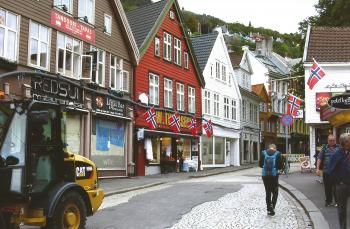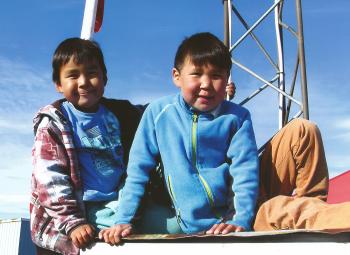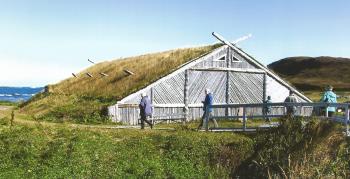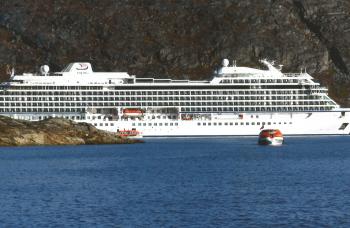‘In the Wake of the Vikings’ – Crossing the North Atlantic
This article appears on page 42 of the February 2017 issue.
In the Wake of the Vikings” read the title of a cruise across the North Atlantic by Viking Ocean Cruises (Woodland Hills, CA; 866/984-5464, www.vikingcruises.com). Viking is known primarily for offering river cruises in Europe and other parts of the world, but this was the first time they would be taking one of their oceangoing ships, the Viking Star, across the Atlantic. It was a 15-day ship relocation cruise from Bergen, Norway, to Montréal, Canada, in September 2016, before the ship moved on to the Caribbean for the winter season.
Frequently, when a cruise line does a relocation, the ship does not have a full complement of passengers. However, on this trip, the ship was virtually full because many of the passengers had taken prior river cruises with Viking and were intrigued by this itinerary.
Beginning in Bergen
The cruise began in Bergen and traveled through the Shetland Islands and the Faroe Islands, continuing to Iceland. From there, the ship made two stops in Greenland and one in Newfoundland, then stopped in Saguenay and Québec City in Québec before its final stop, in Montréal.
The cost for this cruise, including all meals, started at around $6,000 per person. At each stop, there was one included tour and a variety of additional tours that could be purchased.
In Bergen, we had a walking tour throughout the downtown area. The city was founded in 1070, and there were a number of historic wooden buildings downtown that reflected its heritage.
The Torget Fish Market is busy every day.
We were very fortunate to have a partly cloudy day on which to visit. Bergen has more than 200 days of cloudy, rainy weather per year, so any day that has sun is a real treasure.
From Bergen we set sail for Lerwick in Scotland’s Shetland Islands. This city, located on the northern tip of Scotland, is the capital of the Shetlands.
It is a sleepy town, founded by Dutch fishermen, with extensive farmland and meadows covering the landscape. To the west, you can find medieval castles overlooking some of the valleys.
A bumpy night
Our next scheduled stop was at Tórshavn, in the Faroe Islands. However, as we approached this stop, the winds increased substantially, so the captain decided that it was too dangerous to make the stop. Later that evening, we encountered winds in excess of 90 miles an hour and waves higher than 45 feet. This was a true test for the ship.
People who were still eating in the dining room at 9 p.m. were shocked when the ship rolled and everything on their tables slid onto the floor. In addition, a couple of large wine racks toppled and planters and many other things were thrown about the ship. In our stateroom, the desk didn’t have a rail around its edge, so everything on it went flying to the floor.
As the night progressed, we managed to get into our beds, and I wished that we had a safety strap to hold us there. The storm continued for several more hours but abated as morning arrived.
Having skipped the Faroe Islands, our next stop was Reykjavík, Iceland. Included was a city tour around this capital, home to about 120,000 people, nearly half the population of Iceland.
A highlight in this city was the Lutheran church, Hallgrímskirkja, which has a tower about 74 meters tall that provides views of all parts of the city.
Another highlight was the drive up Öskjuhlíð Hill to a vantage point inside a glass building called The Pearl. From the glass dome, we looked out over the city and the airport.
One of the additional excursions offered there was a grand circle tour, which took participants north of the city. About a third of the passengers on the boat took this tour, but by taking this 8½-hour excursion, they didn’t have time for the city tour or a visit to the Blue Lagoon.
Continuing to Canada
Next on our itinerary were Nanortalik and Qaqortoq, Greenland. Both of these stops were interesting in that we were tendered into these small communities, each with a population of around a hundred, at the water’s edge.
It was nice to visit Greenland, but I thought we would have been better off spending more time in Iceland and skipping one of the two Greenland stops.
We sailed on to L’Anse aux Meadows, Newfoundland, Canada, believed to be the site of the first Norse settlement in America. At that site, we saw thatch-roofed houses and a Norse longboat of the type the Vikings used to cross the ocean. These are quite large boats, about 30 yards long and about 10 yards wide, but they are totally open.
From Newfoundland we sailed on to Saguenay, Québec Province, formerly a French colony, situated north of the Saint Lawrence River on the Saguenay River. In this part of Canada, French is the predominant language, although all signs were also in English.
There, we had a chance to attend a stage play, featuring more than a hundred volunteer actors, that depicted the historical development of Saguenay from colonial days to the present. The show included live animals, fireworks and a variety of other theatrics. It was a very entertaining program and was well received by the audience.
Closing in Québec
Sailing west again, we next stopped at Québec City. The most well-known landmark in Québec is Château Frontenac, which dates back more than a hundred years. It is now a Fairmont hotel and has been totally renovated. It was spectacular!
Québec City is quaint, with narrow streets and attractive buildings, and it definitely had a French flavor.
This was a very educational trip on a ship that carries a little over 900 passengers and can cruise at 20 knots. We did have quite an adventure with the storm west of the Faroe Islands, but the ship held up well.
Food on board was excellent, and diners could choose to eat in the main dining room or in either of the two specialty restaurants, one serving Italian fare and the other, a primarily Norwegian menu. These two specialty restaurants required reservations, but those were not difficult to obtain.
Extra amenities on the ship included free Wi-Fi (generally connected), free self-service laundry and lectures on sea-going topics.
This cruise was sold out so quickly that Viking scheduled it again for September 2017 and 2018.
I’d suggest taking this cruise for a chance to see several northern countries not often offered on travel itineraries.




